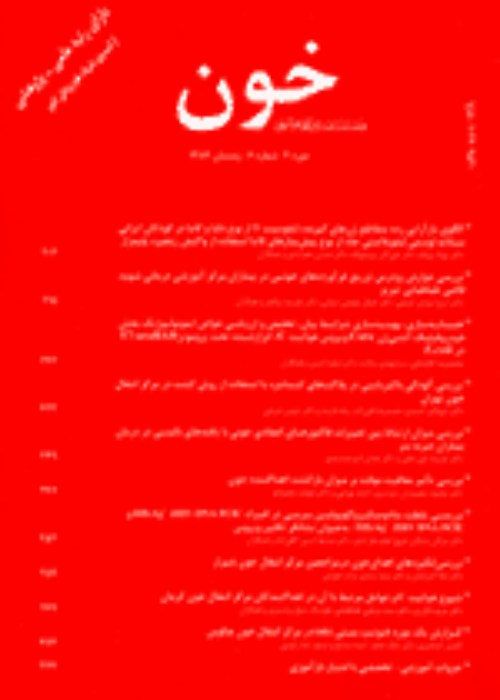Antibody screening and identification by gel method in thalassemic patients
Author(s):
Abstract:
Background and objectivesThalassemic patients need regular blood transfusion because of chronic nature of disease. Since just major blood groups are controlled in compatibility tests, formation of antibody against minor blood groups (irregular antibodies) can cause transfusion reactions (delayed hemolytic reaction) and may produce complications for patients. In this study, we decided to perform screening and typing of antibodies with gel method and tried to substitute this modern method for routine tests. Materials and MethodsIn a descriptive study 441 thalassemia patients having referred to two thalassemic centers in Tehran and Ghazvin were studied. Data forms about blood transfusion status were filled out for all patients from whom blood samples were then taken. Screening antibody test with tube method was performed for all patients followed by assessment with gel method according to its standard pattern and respective program. Antibody identification test was performed according to the respective program as well. Results of obtained data from forms filled out by patients were assessed with SPSS 11.5 software; chi-square test was done with 95 % confidence interval. Results441 patients consisting of 234 males (53.1%) and 207 females (46.9 %) with the mean age of 22.6 years (SD ± 9.27) participated in the study. Out of the total number of subjects, there are 362 thalassemia major (82.1%) and 79 thalassemia intermedia (17.9%). Screening showed 391 patients (88.7%) without versus 50 (11.3) with alloantibodies. From among identified antibodies, anti-Kell and anti-D were present in 28% and 16% of cases respectively; antibodies to other Rh subgroups including c, C, e, E and Cw appeared in 26% of cases. Comparing results of microtube gel method with tube method for screening shows that 26 patients recognized as positive in gel method were negative in tube method. ConclusionsRegarding the alloimmunization frequency in thalassemic patients, it is suggested that RBC phenotype especially subgroups of Rh, Kell, Kidd, and Duffy be checked (in addition to ABO Rh(D) group) for every newly diagnosed thalassemia patient; it is further recommended that in every crossmatch for blood transfusion. Blood bag be selected based on Rh subgroups and Kell in conformity with patient phenotype; this would decrease alloimmunization by 90%.
Language:
Persian
Published:
Scientific Journal of Iranian Blood Transfusion Organization, Volume:5 Issue: 2, 2008
Page:
99
magiran.com/p556872
دانلود و مطالعه متن این مقاله با یکی از روشهای زیر امکان پذیر است:
اشتراک شخصی
با عضویت و پرداخت آنلاین حق اشتراک یکساله به مبلغ 1,390,000ريال میتوانید 70 عنوان مطلب دانلود کنید!
اشتراک سازمانی
به کتابخانه دانشگاه یا محل کار خود پیشنهاد کنید تا اشتراک سازمانی این پایگاه را برای دسترسی نامحدود همه کاربران به متن مطالب تهیه نمایند!
توجه!
- حق عضویت دریافتی صرف حمایت از نشریات عضو و نگهداری، تکمیل و توسعه مگیران میشود.
- پرداخت حق اشتراک و دانلود مقالات اجازه بازنشر آن در سایر رسانههای چاپی و دیجیتال را به کاربر نمیدهد.
In order to view content subscription is required
Personal subscription
Subscribe magiran.com for 70 € euros via PayPal and download 70 articles during a year.
Organization subscription
Please contact us to subscribe your university or library for unlimited access!


